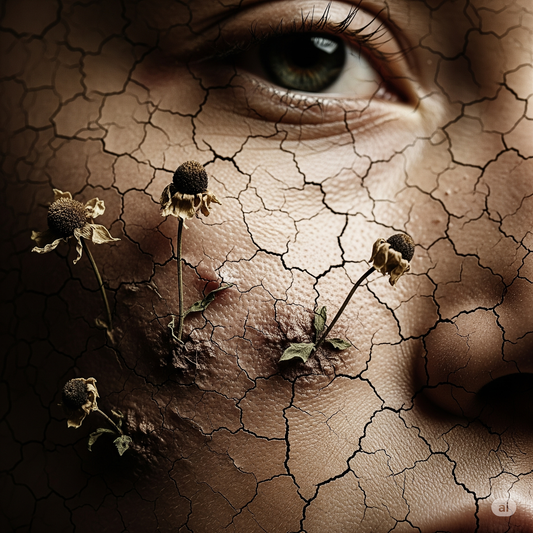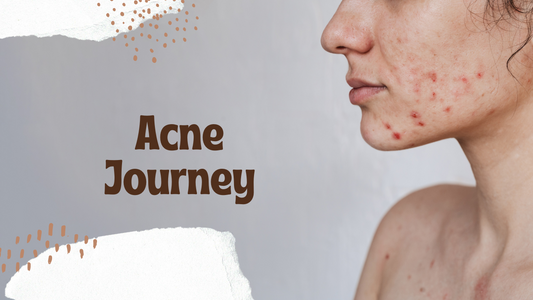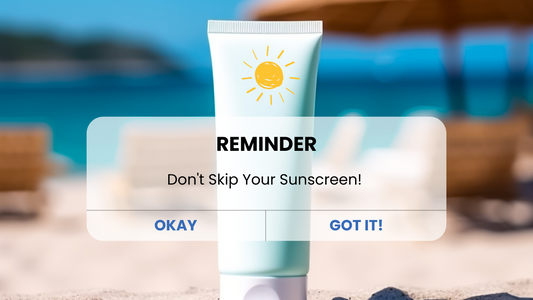Beginner Guide: Skincare for the Skeptical Beginner
Index
Why Even Bother? | What’s the Bare Minimum? | Will It Even Work for Me? | Isn’t This Too Complicated? | What If My Skin Freaks Out? | Fine—I’ll Try It | FAQ | Glossary | References
Why Even Bother?
If you're skeptical about skincare, you're not alone. Maybe you’ve always gotten by without any products. Maybe it seems like a marketing scam—or a trend you missed. But here's the truth: a basic skin care routine isn’t about vanity, it’s about protection and prevention.
Think of your skin as a barrier. Every day, it deals with pollution, dirt, sun exposure, and weather changes. Over time, this wears down its defenses, leading to premature aging, dullness, breakouts, or dryness. According to the American Academy of Dermatology, even a simple routine can improve the skin’s appearance and function in just a few weeks.
And it’s not just about looks. People with consistent skincare routines often report better self-esteem and confidence. If your skin feels healthy, you feel more comfortable in it.
What’s the Bare Minimum?
You only need three products to get started with a basic skincare care routine for beginners:
-
Cleanser – This removes the dirt, oil, and dead skin that builds up daily. It preps your skin for everything else.
-
Moisturizer – Helps your skin retain hydration, making it feel smooth and resilient.
-
Sunscreen – Blocks harmful UV rays that cause aging and skin damage. This step is non-negotiable, even indoors.
Each of these plays a distinct role. Think of cleanser as a reset, moisturizer as protection, and sunscreen as armor. When used daily, they create a foundation for healthier skin.
For beginners with oily skin, try a lightweight gel cleanser and oil-free moisturizer. If your skin is dry, look for cream cleansers and rich moisturizers.
Will It Even Work for Me?
Yes, but with patience. Unlike viral makeup trends or overnight masks, skincare takes time. The goal isn’t instant perfection—it’s consistent improvement. Think of it like working out: progress is gradual.
In the first week, your skin may feel more balanced. Within a month, you may see fewer breakouts or less flakiness. Long-term benefits include fewer fine lines, even tone, and stronger skin barrier.
If you're still doubting, start by using basic skin care routine steps for 30 days. Stick to the routine and observe how your skin feels—more hydrated? Less irritated? That’s progress.
Also, choose products with minimal ingredients. Fragrance-free, alcohol-free options are a good start.
Isn’t This Too Complicated?
It only looks complicated online because people love showing off 10-step routines and shelves full of products. But you don’t need all that. Here’s a realistic daily routine for beginners:
Morning:
-
Step 1: Cleanse – Just splash water if your skin isn’t oily.
-
Step 2: Moisturize – Hydrates and preps the skin.
-
Step 3: Apply Sunscreen – Use SPF 30+ even indoors.
Night:
-
Step 1: Cleanse – Start by washing your face with a gentle face wash to remove dirt, oil, and any leftover sunscreen or makeup.
- Step 2: Treat – This is where you target your specific skin concerns. Whether it's acne, pigmentation, or wrinkles, apply actives accordingly.
- Step 3: Moisturize – Go for a slightly richer moisturizer than your daytime one to help your skin repair and hydrate overnight.
Not sure why there's a difference between day and night routines? It’s all about how your skin behaves! For a better understanding, check out this Day & Night: Why Your Skincare Routine Should Shift With the Sun blog that breaks it down simply.
That’s it. No masks, no oils, no serums—unless you want to explore later. If you're oily, go for gel-based products. If you're dry, opt for thicker creams. Combination skin? Use lightweight products that balance both zones.
Don’t Skip Exfoliation (But Start Slow)
Exfoliation helps remove dead skin cells and can leave your skin brighter and smoother—but it’s easy to overdo.
- Start 1x per week with a gentle chemical exfoliant line retinoic acid
- Avoid harsh scrubs, especially with acne or sensitive skin.
- Gradually increase to 2x per week if your skin tolerates it.
Formial’s personalized solutions include precisely measured actives like retinoic acid to help you ease into exfoliation safely and effectively—without the guesswork.
Think of exfoliating as spring cleaning
What If My Skin Freaks Out?
This is one of the most common fears—and one of the easiest to manage. Skin can “purge” when you start using new products, especially those with exfoliants or actives. But with just the basics, this is rare.
Still, here’s what to do if your skin acts up:
-
Get back to basics – Stop all extras and go back to just cleanser and moisturizer.
-
Introduce one product at a time – Wait 3–5 days before adding another.
- Patch test – Apply a small amount on your inner arm or behind your ear and wait 24 hours.
If irritation persists, look for products labeled "for sensitive skin," “fragrance-free,” or “non-comedogenic.”
Fine—I’ll Try It
Welcome to Team Try-It! Starting a basic skincare care routine for beginners doesn’t mean a lifelong commitment to fancy products. It’s about learning what your skin likes and giving it what it needs.
Here’s your 30-day challenge: Cleanse, moisturize, and wear SPF every day. Nothing more. After that, you can decide if your skin feels better—and if you want to explore more.
Still skeptical and want your skincare actually personalized? Formial's custom-made skincare blends prescription actives into a one-step cream based on your skin's concerns—so you don’t need to guess what works.
FAQ
-
Do I need all three steps?
Yes—each step plays a vital role in supporting your skin’s health. Cleansers remove dirt, oil, and buildup, moisturizers hydrate and strengthen your skin barrier, and sunscreen protects against UV damage and premature aging. Skipping one weakens the routine's effectiveness. -
Can I skip sunscreen if I’m indoors?
No—UV rays still reach you through windows. UVA rays, which contribute to aging and skin cancer, penetrate glass and continue to harm your skin even indoors. Consistent sunscreen use is crucial, whether you're inside or out. -
Is this for men too?
Definitely. Skincare is for all genders. Men have different skin characteristics (like thicker skin or more sebum production), but the basics—cleansing, moisturizing, and protecting—remain essential regardless of gender. -
What if I don’t know my skin type?
Start with products for normal or sensitive skin. These are usually gentle and non-irritating, making them a safe starting point. As you observe how your skin reacts, you can adjust your routine based on oiliness, dryness, or sensitivity. -
Can I use one product for everything?
All-in-ones exist, but they often underperform. Skincare products are usually formulated for specific functions, and combining too many into one can dilute their effectiveness or create imbalances in pH, moisture, or active ingredients. -
How long before I see results?
4–6 weeks with consistent use. Skin regenerates roughly every 28 days, so visible improvements like smoother texture or reduced breakouts require patience and steady routine use. Results may vary depending on the concern and product type. -
Is toner necessary?
Not at all. Toners are optional and can be skipped unless your skin specifically benefits from one. If you enjoy using one, opt for an alcohol-free formula with soothing or hydrating ingredients. -
Should I double cleanse?
Only if you wear heavy makeup or SPF. Double cleansing (usually with an oil-based cleanser followed by a water-based one) ensures thorough removal of stubborn products. For light makeup or no SPF, a gentle single cleanser is enough. -
How to patch test?
Apply a small amount on your arm and wait 24 hours. This helps you identify allergic reactions or irritation before using a product on your face. Look for redness, itching, or bumps in the test area. -
Are DIY remedies okay?
Some may help, but many (like lemon juice) are too harsh. While natural ingredients sound appealing, their concentration and pH can harm your skin. Stick to well-formulated, dermatologically tested products for safety and efficacy.
Glossary
Non-comedogenic – Won’t clog your pores.
SPF (Sun Protection Factor) – Measures how well sunscreen blocks UVB rays.
Purging – Temporary breakout caused by faster skin cell turnover.
Hydration vs Moisture – Hydration adds water; moisture seals it in.
Fragrance-Free – Contains no added scent; safer for sensitive skin.
Actives – Ingredients like retinoids or acids that change skin behavior.
Barrier – Your skin’s outer layer that protects from damage and water loss.
References:
-
Draelos, Z. D. (2016). Skincare bootcamp: The evolving role of skincare. Journal of Clinical and Aesthetic Dermatology, 9(11), 25–27. https://www.ncbi.nlm.nih.gov/pmc/articles/PMC5172479/
-
Kircik, L. H., Del Rosso, J. Q., Schlesinger, T. E., & Zeichner, J. A. (2022). Expert consensus on holistic skin care routine: Focus on acne, rosacea, atopic dermatitis, and sensitive skin syndrome. Journal of Cosmetic Dermatology, 21(1), 45–52. https://onlinelibrary.wiley.com/doi/full/10.1111/jocd.15519
-
American Academy of Dermatology Association. (n.d.). Basic skin care: Tips from dermatologists. Retrieved from https://www.aad.org/public/everyday-care/skin-care-basics/care
-
McLeod, R. P., Horowitz, P., Fowler, J. F., & Eichenfield, L. F. (2013). The basics of skin care: cleanse, moisturize, protect. Seminars in Cutaneous Medicine and Surgery, 32(2 Suppl 2), S28–S30. https://www.researchgate.net/publication/258041763_The_basics_of_skin_care_cleanse_moisturize_protect
-
Zhang, L., Adique, A., Sarkar, P., Shenai, V., Sampath, M., Lai, R., Qi, J., Wang, M., & Farage, M. A. (2020). The impact of routine skin care on the quality of life. Cosmetics, 7(3), 59. https://doi.org/10.3390/cosmetics7030059
-
Medical News Today. (2022). Dermatologist-recommended skin care: Tips and routine. Retrieved April 2025, from https://www.medicalnewstoday.com/articles/dermatologist-recommended-skin-care





